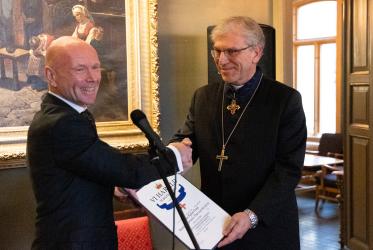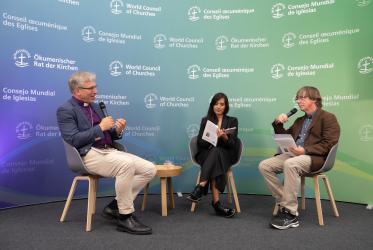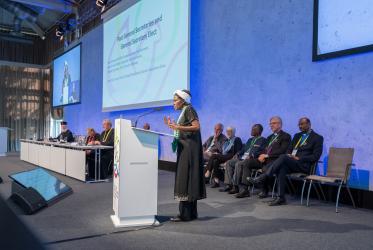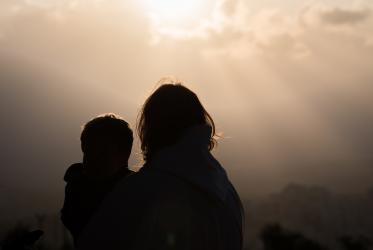Reflection at the World Council of Churches Staff Planning Days 6-9 March by the WCC General Secretary, Rev. Dr Olav Fykse Tveit.
Geneva 6 March, 2017
These days we are looking together to 2018, to see how we can plan for what we do that year to fulfil the calling and purpose of the World Council of Churches. This will be an exercise of looking in two directions at the same time but for the same purpose. We will look forward to where the pilgrimage of justice and peace is leading us – in terms of a contextual focus on Latin America and the potentials both for more peace and more injustices in that region, but also analysing and discerning the times in which we live and what we should contribute in this time that can be an account of the hope that we are carrying together. We will also look to the last 70 years of the World Council of Churches. Did you notice, now I do not use the acronym? I did not only to be gentle to newcomers who do not know all our tribal acronym language, and some of us veterans might also have some problems with them! - but to turn our eyes for a moment from the screens showing our plans and our objectives towards the tapestry here in this room. The churches are symbolized with their different buildings. But what is their connection, where is the clear reporting line to the WCC? How are they connected through the World Council of Churches? The anniversary dimension shall follow us in many ways, but today I will elaborate one dimension of it that is relevant for all perspectives we put into our planning activities these days.
Last week I was in Addis Ababa, together with several colleagues and Dr Agnes Abuom, the moderator of the Central Committee, to attend the 54th meeting of the World Council of Churches’ Commission of the Churches on International Affairs (CCIA) . It was indeed a good experience to work with these committed and gifted commissioners, searching the prioritized tasks for them in the wider structure and plans of the WCC as they exercise the very significant task of guiding the council and churches and many other partners to elaborate what working as churches together for justice and peace means in different contexts of the world. No wonder that the peak of the energy in the room was when they discussed how the new president of the USA affects the churches and the peoples in the USA and in the whole world. Some of them were very surprised to hear that there were quite different reactions in different parts of the world. My contribution to that reflection, but I think also to the work of the commission, and I would say also relevant for the whole work of the WCC that we are planning for, was the following question: “What does it mean today (and in 2018) to believe together in the one God, who has created the one humanity where everybody is created in the image of God?”
I also had the chance to have meetings with the leaders of the Ethiopian Orthodox Church and the Ethiopian Evangelical Church Mekane Yesus. Patriarch, H.H. Mathias, visited the WCC offices and Bossey a few weeks ago and he expressed his delight and gratitude for the way he was received. Furthermore, he emphasized his admiration for all the WCC and its staff is doing for the unity of the church, for justice and peace in the world. The church must always work for peace, he said in an interview published by WCC communications after his visit.
These are sincere words to you, my colleagues, from a leader of a the church with the oldest ancient roots in the world, the largest African church, and a church of almost 45 million members that has no other global international platform and organisation than the WCC. The EEMYC, member of both LWF and WCRC, has a change in its leadership these days. Yesterday, Rev Yonas Yigezu was installed as president after the outgoing president Wakseyoum Idossa, who is a member of the WCC Central Committee. Our colleague Nigussu Legesse was there, and exceptionally he was granted absence for the two first days of the SPD. Their recorded membership now counts more than 8.3 million, and it has grown fast the last 50 years to become the largest member church of LWF. They reminded us that there are many challenges in the great country of Ethiopia. They and the Patriarch appreciated very much that we addressed the outbreak of violence last fall and urged the government to find non-violent ways of stopping it, through a letter and a pilgrimage team visit lead by Dr Agnes Abuom. We could observe still that the state of emergency and heavy influence of the military forces is a reality. Soldiers were everywhere and on every street corner in Addis. Significant groups of people are not given access to power, there is a significant and life-threatening drought that leads to famine if not responded to immediately, there are several restrictions on freedom of expression.
They and many others look to the WCC, with a question: what can we contribute as a world wide fellowship? How can we give contributions to see the richness and the strength of the peoples of Africa, their growth in faith and as churches, but also help to focus on justice and peace as our common agenda, on the urgent needs, how can the WCC help to say the truth, how can the WCC as a fellowship with its partners in the ACT Alliance contribute to signs of hope?
All the commissioners and these church leaders attended the opening of the Lenten campaign, Seven Weeks for Water, for water justice in Africa. The Ecumenical Water Network helps them and all of us to focus on the basic right to affordable, accessible, clean water – and I preached the word of the prophet Amos: Let justice roll down like waters. Water is a matter of justice. Water is also a metaphor of the justice of God. That will come, this way or the other. And the words of Amos continue to give them hope in all the injustices many experience. This is the message of the WCC of today as it has been the last 70 years.
I say this about Ethiopia to remind us of our context, our identity as a fellowship of churches, our networks, our agendas, and how they are connected, how relevant, even urgent our work is as a pilgrimage of justice and peace. For our work these days, that is not only relevant to the focal point of 2017 on Africa. WCC deputy general secretary Dr Isabel Apawo Phiri will tell you more about the reflections of the RGPJP for this year and the next years. I say this so that we are reminded who we are here on behalf of many who are represented with the symbols of the churches on the tapestry in front of us when we enter this room.
However, there is something more to be said about how this gives us a vision of who we are and what it means to plan for 2018 together. That they all may be one,. The famous words from Christ’s prayer for all his believers, then and now, are giving us the rationale for why we are. So that the world may believe. Next year we will be focusing on the mission of the church – promoting the mission conference and its theme on transforming discipleship. This is related to the work for unity through the expression of the purpose of being one: SO that the world may believe. Nothing less.
There are many ways to elaborate further what this prayer says and what kind of unity we are seeking as we pray with Christ that they all may be one. I would like to give a direction to this that I have not emphasized before in my exegesis of this text. There is a parallel structure here as in many biblical texts, two sentences saying almost the same after one another. Verse 17:21: “that they may all be one…so that the world may believe that you have sent me” and verse 17:23: “that they may be completely one, so that the world may know that you have sent me and loved them even as you have loved me.”
These words are connected to the whole of the Gospel of John, in so many ways. They are also relating to the words in the conversation between Jesus and Pilate in the next chapter. “My kingdom is not from here. You say that I am a king. For this I was born, and for this I came into the world, to testify to the truth. Everyone who belongs to the truth listens to my voice. Pilate asked him: “What is truth?” (18: 36-38)
The unity among the disciples is needed for the world to believe – to know – that in Jesus we have seen the true God and heard the truth about God. The disciples belong to a group that is persecuted by the world, named here as the Jews. We should see these not as an accusation against Jews of today, but as a way to describe the conflict between the ones who come to share the truth and those who resist. And what is the truth? The truth is that there is one God, and that this God has loved the world. The truth is that the disciples have a role to show that the One God sending Jesus Christ to show the love and the solidarity and give the peace in a world of darkness, sin, injustices, lies, untruth, abuse of power, polarization, imperialism, nationalism, violence in the name of religion, discrimination, ignorance, exclusion, crucifixion - war - this God actually cares for all human beings and for the whole world, also the whole creation.
There is a struggle about the soul of religion and of Christianity. Is it a faith that can be used to polarize, give privilege to some and not to others, to exclude, to ignore the needs of the others for your own sake? The discussions in the US these days are disturbing and shocking. Not only because we do not quite believe what we hear. But also because we know that this is a mirror of many contexts, many dimensions of human history and human reality of today, also supported in the name of religion and even Christianity.
Our search for unity is challenging, we are not always in agreement or in consensus. But we have a wider basis of common ground, given in Jesus Christ, exactly in Jesus Christ as an expression for the love of God, the Father and the creator of all, and the one to whom the HS witnesses avery day - and in his name shows us the truth, also the judgement about justice.
The faith of the church is in the crucified and risen Christ. The hope we have is coming from the resurrection as a sign of the coming kingdom of God. The hope we have is not that the evening will be nice and quiet. The hope we have is related to the coming morning of God, therefore the values we are promoting should correspond to what is coming, not only making nice something for ourselves at the end of everything.
Let waters roll down. Let the truth be known. May they all be one.
We are at the centre. The Ecumenical Centre, but also at the centre of the most essential questions of the world. What is truth?
The centre and the margins. The centre where people are struggling for life, where Christ is. Often what we think we are the margins. The truth can be revealed in the margins. Like in Jerusalem to Pilate.
These are the questions that guide as we prepare for the next year in our pIlgrimage, seeking the will of God, seeking how our different and not perfect initiatives or actions or programs or management can serve by the grace of God the richness of God’s creation, of the one humanity, of the One and triune God.



